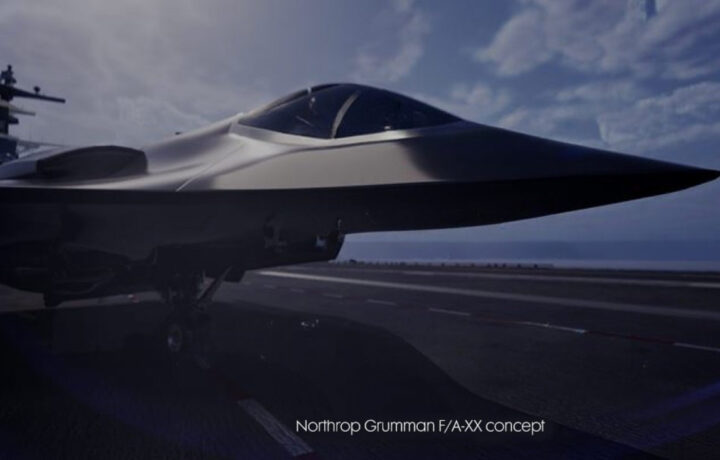The United States Navy has yet to award a contract for its F/A-XX, the sixth-generation manned fighter that will replace its carrier-based Boeing F/A-18E/F Super Hornet. The sea service will receive the final batch of Super Hornets by the end of 2027, and although those aircraft are expected to remain in service until the 2040s, the focus is on their eventual replacement.
As Lockheed Martin was eliminated from the competition in March, it will come down to either Boeing or Northrop Grumman. Details remain sparse, but last week, Northrop Grumman published an official concept art of where it sees the program headed.
The F/A-XX Concept Image
It was just a single image on the aerospace firm’s page for Naval Aviation, which highlighted the role Northrop Grumman plays in the supply chain of currently in-service aircraft, including the F/A-18E/F, the EA-18G electronic warfare variant of the Super Hornet, and even the components (notably the wings) that are on the Lockheed Martin F-35C.
That image, with the words “Project Power Anywhere,” offered the first view of what we could expect from the F/A-XX. Or it could be a concept image far from any prototype. It showed a sleek fighter with a bubble canopy sitting on the flight deck of a carrier.
It offered few other details, but there has already been much speculation online.
TheAviationist offered the opinion that the concept art suggested a fighter with a “focus on low observability,” including a “low-observable air inlet” that is placed at the top of the fuselage. The War Zone provided a similar sentiment that the aircraft was “optimized for stealth,” while it noted that the canopy was “indicative of a single pilot.”
That would be a departure from the F/A-18, which is available in both single-seat and two-seat models. “The idea that this aircraft would be a single-seat design is of interest as some have assumed a two-crew concept would be better for the highly complex, extended range missions it is intended to take on,” TWZ added.
Although only the forward section of the fuselage was visible in the concept art, there is also speculation that it could feature a tailless design.
The F/A-XX’s design was compared to that of the YT-23 Black Widow II, the prototype aircraft built by Northrop for the U.S. Air Force’s Advanced Tactical Fighter (ATF) program in the 1980s. That aircraft was beat out by the Lockheed/Boeing/General Dynamics YF-22, which went on to become the Lockheed Martin F-22 Raptor.
The YF-23 was deemed to offer superior stealth, but was less agile than its competitor. However, the ATF program called for an air superiority fighter to replace the F-15 Eagle, while the F/A-XX is meant to replace the multirole F/A-18 Super Hornet.
The F/A-XX – What We Know
Much like the U.S. Air Force’s Next Generation Air Dominance (NGAD) program’s F-47, which is the centerpiece in a system of systems, the F/A-XX will be the center of a “Family of Systems” (FoS) at the center of the Navy’s NGAD program.
Although both share the same name, they are being independently developed and require different capabilities. Unlike the Lockheed Martin F-35 Joint Strike Fighter, which was produced in three unique variants, the F-47 will be an entirely different aircraft from the F/A-XX.
Moreover, as noted by the concept art, Northrop Grumman could end up producing the Navy’s aircraft while Boeing builds the Air Force’s fighter. That isn’t a sure thing, and there is still a very real possibility that Boeing, having already secured the F-47 contract and having produced the F/A-18 Super Hornet, could win the contract.
Boeing Phantom Works first released a concept image of the F/A-XX back in July 2009, which showed a twin-engined, tailless, two-seat fighter with a blended wing and fuselage.
It remains unclear when the Pentagon will announce the winner of the F/A-XX, but U.S. Navy officials have made clear that, despite past suggestions that there may be a focus on the Air Force’s F-47, the sea service is still all in on its own sixth-generation fighter.




